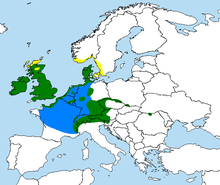Lesser redpoll
| Lesser redpoll | |
|---|---|
 |
|
| Scientific classification | |
| Kingdom: | Animalia |
| Phylum: | Chordata |
| Class: | Aves |
| Order: | Passeriformes |
| Family: | Fringillidae |
| Genus: | Acanthis |
| Species: | A. cabaret |
| Binomial name | |
|
Acanthis cabaret (Statius Müller, 1776) |
|
 |
|
|
Summer Resident Winter |
|
| Synonyms | |
|
Carduelis cabaret |
|
Carduelis cabaret
Carduelis flammea cabaret
Acanthis flammea cabaret
The lesser redpoll (Acanthis cabaret) is a small passerine bird in the finch family, Fringillidae. It is the smallest, brownest, and most streaked of the redpolls. It is sometimes classified as a subspecies of the common redpoll (Acanthis flammea) but has recently been split from that species by the British Ornithologists' Union. It is native to Europe and has been introduced to New Zealand. Many birds migrate further south in winter, but the mild climate means that it can be found all year round in much of its range, and may be joined by the other two redpoll species in winter.
The genus name Acanthis is from the Ancient Greek akanthis, a name for a small now-unidentifiable bird, and cabaret is the French name for a type of finch.
The relationships among the redpolls are unresolved. The lesser redpoll co-occurs with the mealy redpoll (subspecies flammea of the common redpoll) in southern Norway, apparently without significant interbreeding though sympatry was established too recently to draw firm conclusions.
It is a small, short-tailed finch, 11.5–12.5 centimetres (4.5–4.9 in) long with a wingspan of 20–22.5 centimetres (7.9–8.9 in) and a weight of 9–12 grams (0.32–0.42 oz). The bill is short, conical and sharply pointed and is pale yellow with a dark tip. The adult male is largely brown above with darker streaks. It has a red forehead, a black chin and, during the breeding season, pink on the breast and face. The flanks are buff with dark streaks and the belly and undertail-coverts are whitish. There are two pale bars on the wing. The adult female is similar but lacks the pink on the breast and face and has less streaking on the flanks. The juvenile has a pale head with no red forehead and less black on the chin.
...
Wikipedia
